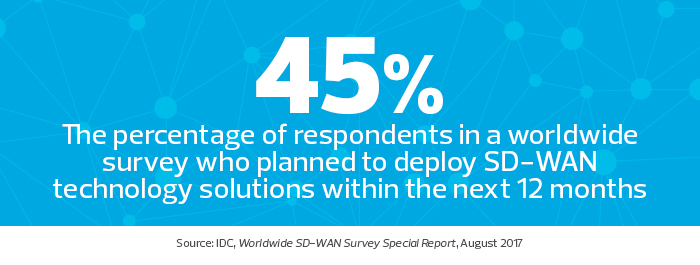SD-WAN Offers States an Affordable Way to Securely Connect Remote Locations
More people are working out of the office, but they still want the benefit of being at their desk on a high-speed network. To deliver that in-office experience, government IT teams must make sure that voice, video and other collaboration tools perform well. As state and local governments strive to improve customer service, they must ensure their networks extend to decentralized locations to support branch offices, kiosks and remote workers.
Network managers have always used various technologies and network appliances to build reliable and speedy WANs, but it has been difficult to make sure that everything works together. They may find a simple solution with software-defined WAN, which can be used to optimize performance, secure branch office edges and deliver a better user experience to remote offices.
SD-WAN products are affordable options that separate networking hardware from its controls, virtualizing those controls between central networks. For example, state and local governments can connect the networks of branch offices across large distances through the cloud. SD-WAN delivers three valuable capabilities in a single solution: traffic management, performance optimization and application visibility.
SIGN UP: Get more news from the StateTech newsletter in your inbox every two weeks!
Traffic Management for Real-Time Government Collaboration
Many budget-conscious state and local agencies are shifting from expensive multiprotocol label-switching or other private-line services to the internet for WAN connectivity. However, they often discover that robust performance is not guaranteed. While the internet itself can be a source of performance problems, it’s just as common to see local users competing with each other — unintentionally — for limited bandwidth. One user downloading software updates or uploading backups can interrupt voice calls or create choppy video performance for others.
SD-WAN solutions provide much stronger management of traffic flowing between local users and the rest of the world, including both the internet and corporate applications, even over VPNs. Originally, network managers had primitive quality of service/class of service tools to manage application traffic. QoS/CoS worked well in very tightly defined networks with predictable link performance, but few agencies want to pay for a completely private network. When the internet becomes part of the WAN, more sophisticated tools are needed.
SD-WAN devices are able to reserve bandwidth for real-time collaboration applications, such as voice and video, while policing recreational and background traffic such as backups — and they can prioritize other enterprise applications properly.

This additional traffic management can be very sophisticated. For example, SD-WAN solutions can detect congestion and slow down web-based applications or email so that more bandwidth is available for voice and video traffic.
When offices are connected with more than one link — always a good idea for high reliability — SD-WAN can also intelligently allocate traffic across links, separate real-time voice and video collaboration streams from other types of traffic, and in some cases use both links at once for a single critical application to provide the very highest level of performance.
SD-WAN Offers Optimized Performance
Most SD-WAN tools derive from older performance optimization technology: WAN optimization. Many vendors still include performance optimization features in their devices as a way to squeeze even more out of private and public links.
Performance optimization is carried out by different products using different techniques, including caching of previously downloaded content and data deduplication. The most common technique is compression, which reduces the size of data transmissions. Many data streams are quite compressible, especially those from legacy applications. These applications generally don’t offer built-in compression, so having an SD-WAN tool between the user and the application that simply makes it go faster is a huge benefit.
Some SD-WAN devices go deeper and look into the Transmission Control Protocol/ Internet Protocol (TCP/IP) state machine, changing protocol behaviors to speed performance.
The drawback with many performance optimization techniques is that they work best when using two SD-WAN devices: one near the end user and one near the application server. For agencies that maintain their own data centers, deploying two SD-WAN solutions is relatively simple. But as applications are moved to cloud data centers, SD-WAN performance optimization becomes more difficult.
Although performance optimization tools may help some applications, collaboration tools that use real-time traffic, including voice and video, get no direct benefit. Caching and compression, for example, don’t help because voice and video are already compressed. They usually run over User Datagram Protocol, so adjusting the TCP state machine won’t help.
However, bandwidth is finite; making other applications run more efficiently will open up network resources for real-time collaboration applications.
Application Visibility Provides a Complete Picture
Every network manager dreads the call: “I can’t work because the network is slow.” Problems that might have been hard to solve in a central building LAN environment become nearly impossible when far-flung WAN links and remote offices are involved.
SD-WAN solutions can change that. Because SD-WAN tools need to be application-aware for their traffic management and performance optimization tasks, they can easily export that information to other network management tools, such as NetFlow/IPFIX collectors. By offering a more complete picture of exactly what applications are being used and how those applications are performing, SD-WAN devices can give insight into network operations that weren’t possible with older edge devices.








